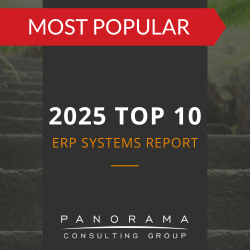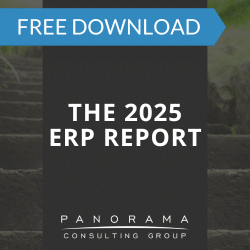- Cultural resistance to modern ERP often stems from leadership discomfort with system-driven transparency and data-driven decision-making.
- Creating a data-driven culture depends on role clarity, trust in data, and visible executive modeling.
- Many data-driven culture examples show that tools like ERP and AI only gain traction after organizations define shared meanings and accountability for data.
- A data-driven culture in business thrives when decisions, incentives, and business rhythms consistently reinforce the use of data insights.
In many executive teams, gut instinct still guides the biggest decisions. That instinct often comes from decades of experience—pattern recognition, customer knowledge, operational intuition. It’s earned, respected, and often right.
But that legacy of success can predispose stakeholders to distrust ERP system forecasts, bypass dashboards, and choose instinct when data and intuition collide.
If you’re investing in modern ERP systems and AI-driven analytics, then creating a data-driven culture is essential. User adoption requires a cultural shift in how leaders think, how stakeholders make decisions, and how employees are held accountable.
Today, we’re exploring the complexities of cultural resistance to modern ERP and sharing examples of what data-driven cultures look like.
ERP Training Plan Success Story
We helped this manufacturer implement an ERP training strategy to increase user adoption of its new ERP system.
Cultural Resistance to Modern ERP: What it Looks Like
This is especially true when:
- Financial consolidations become automated, reducing manual judgment.
- Sales forecasts are generated by predictive models rather than gut feel.
- Operational exceptions are flagged and tracked by the system in real time.
In these cases, we often hear concerns about “loss of control” or “one-size-fits-all logic.” Left unaddressed, these concerns lead to executive disengagement, and ultimately, end-user resistance.
Executives Can Quietly Undermine Transformation
Why?
- They don’t think the data captures the nuance of their client relationships.
- They believe they need to move faster than the system allows them to.
- They trust their team more than an automated decision-making model.
While these are rational objections, they create a silent double standard: employees are asked to follow new processes while leadership continues to operate on legacy instincts.
That’s when transformation stalls.
Creating a Data-Driven Culture: What Actually Works
Shifting your culture to one that values data over instinct starts with leadership behavior. Here are five practices we recommend for CEOs and CFOs looking to create a data-driven culture in business.
1. Start with the Decisions That Matter Most
Examples of the types of decisions that drive value include:
- Pricing
- Capital allocation
- Forecasting
- Resource prioritization
Your executive steering committee should review one high-impact decision each month through a data-first lens.
When employees see that data is highly valued among executives, they are more likely to make data-driven decisions themselves.
For example, a global NGO might pilot an AI-enabled forecasting module within its ERP system to allocate grant funding across regions. This would show staff that predictive insights—not just past spending patterns or senior judgment—are central to strategic decisions.
(Note: When it comes to data buy-in, AI readiness consultants are just as essential as change management consultants.)
2. Put Data Accountability in the Org Chart
Data-driven cultures require clearly defined roles, such as:
- Data owners
- Data stewards
- Data analysts
- Decision-makers
Many of the manufacturing companies we work with struggle to drive user adoption of supply chain analytics due to unclear data ownership. We often suggest restructuring parts of the organization to include cross-functional data councils that can set standards and resolve conflicts. This gives employees confidence in the data they’re using—because they know who’s accountable for its accuracy, and who to turn to when something looks off.
3. Operationalize Data in Business Rhythms
If data lives outside the cadence of business decisions, it won’t influence outcomes. That’s why we emphasize integration into operational planning cycles, monthly business reviews, and performance management routines.
For example, a consumer goods company might build their S&OP meetings around real-time ERP data, including backorders, demand signals, and supplier constraints. Over time, gut instinct may give way to structured debate—because everyone is working from the same version of the truth.
4. Train for Interpretation, Not Just Usage
Giving people access to dashboards is not the same as building a data-driven culture. Employees need support to interpret data, question assumptions, and connect insights to decisions.
Our change management consultants often recommend layered training: technical onboarding for system navigation, followed by facilitated workshops where teams walk through real business scenarios using live data. This creates psychological safety around “getting it wrong” and accelerates data fluency.
More importantly, it reduces dependence on informal networks and intuition.
5. Reward the Behavior You Want to Scale
If data-informed decisions get reversed without explanation—or if high performers succeed by working around the system—your culture won’t change.
One of the most common gaps we see is misaligned incentives.
For instance, a sales team might be rewarded for top-line growth even if their forecasts are wildly inaccurate. In this case, no analytics tool will drive adoption. The behavior is rational—the incentives are broken.
That’s why we push executive sponsors to align KPIs, incentives, and performance feedback loops with specific adoption goals. This will make it clear: data-informed behavior wins.
Data-Driven Culture Examples Across Industries
Across all sectors, successful digital transformations are “culture first.” ERP, BI, and advanced analytics only become levers after trust and shared language take root. Without that foundation, even the top ERP systems struggle to gain traction.
We’ve seen this play out repeatedly:
- In healthcare, some organizations invest in advanced analytics platforms to improve cost-of-care decisions, yet find that clinicians and finance leaders interpret the same data differently—or reject it entirely. Until the organization builds shared definitions and mutual trust around what the data means, the platform remains underused.
- In manufacturing, companies often deploy plant-level KPIs through ERP or MES dashboards, only to discover that operators distrust the metrics—either because they conflict with lived experience or because the source data feels disconnected from reality. The real shift happens only after leaders model transparency and involve line supervisors in defining what “success” looks like.
- In professional services, ERP systems can surface detailed margin and pipeline insights, but employees may still prefer Excel because it “feels more accurate.” In these cases, adoption improves only after the firm agrees on how utilization is measured, who owns the numbers, and how they’ll be used in performance conversations.
Modern ERP Requires an Internal Cultural Shift
Many organizational cultures still reward speed over rigor, instinct over evidence, and heroism over process.
To create a data-driven culture in business, executive leaders must treat culture like a system constraint—something to design for, measure against, and engineer intentionally.
Our independent software consultants build transformation strategies that work in the real world—where instincts run deep and culture is the hardest part of change. If you’re navigating a cultural shift, we’d be glad to help.














